- Our Mission

6 Tips for Using Google Tools to Teach Writing
These strategies for organizing writing assignments increase students’ independence and confidence and reduce teachers’ grading time.

Although I have always approached writing in a scaffolded “I do, we do, you do” model, I have never before asked students to collaborate with their peers to make their thinking visible. Google Slides enables students to practice writing interactively with writing models, sentence starters, and drag-and-drop review of major vocabulary terms, and above all it encourages organization by curating their ongoing work in one space.
The following six tips have helped increase the confidence that my students have in their writing ability and in turn significantly elevated participation and work completion.
How I Use Google tools to Structure Writing
1. Number the step in each assignment: In one assignment, I ask students to compare theme across two texts. It sounds simple enough, but when I number each step of the scaffolded writing process in Google Classroom, communication with my students becomes so much clearer. As we approach the final draft of our essay, for example, I say to students, “OK, open numbers 9, 13, and 14 and begin editing!” Long gone are the days when students riffle through crumpled papers to find a graphic organizer. Instead, their writing is organized in small mini-assignments in Google Classroom. Students understand what I am asking and get to work immediately.
Numbering assignments also makes it much easier for students who are absent to communicate clearly what work they need to make up. Here’s an example:
- Practice: Writing a Thesis Statement
- Main Idea Versus Theme
- Practice Comparing Two Texts
- Partner Practice: How to Write an Introduction
- Outline for Introduction Paragraph
- Quotation Integration Practice
- Partner Practice: Writing Your Body Paragraphs
- Summary Versus Analysis
- Outline for Your Body Paragraphs
- Partner Practice: Writing a Conclusion
- Final Draft
2. Create notes that allow students to practice skills interactively: Group work doesn’t always come to mind when teachers think of writing, but I use Google Slides to create model paragraphs that students can edit and complete together.
Here’s an example:
- First, we examine the basic body paragraph that I have written myself to walk students through. We use two brief texts from CommonLit as the model throughout each part of the writing process, beginning with a model thesis statement that we create together. For their own essay, students select from a myriad of short stories we have read together to devise their own thesis statement.
- Color is key. We color-code each part of the body paragraph to be intentional in ensuring that students will incorporate all parts of the body paragraph in their own writing.
- When students practice with a partner, they complete a second body paragraph together. We leave sentence frames similar to the model paragraph to provide support and boost confidence. Students keep the model paragraph in view as they create their own second paragraph.
- When students move on to comparing their own two texts, we ask them to keep this activity tab open to use as a guide. This significantly boosts independence in their writing and removes the common “I don’t know where to start” response.
3. Make it public: After we practice creating thesis statements and writing their introduction paragraphs, students post them to Google Stream. If students feel insecure about posting, they send their final introduction paragraphs to me, and then I post them anonymously. We talk through each student example as a class, providing constructive feedback. Students get ideas from their peers on how they might structure their writing, word choice, transitions, and other changes they might make.
4. Use short texts to stand as class models throughout the writing process: I use CommonLit to find comparison texts to stand as the class model as we move through each scaffolded step of the writing process. After we read two short stories as a class, we use these texts to write class thesis statements together, to review the difference between analysis and summary, to select intentional quotes that will best support our argument, and so forth.
This allows for repetition and familiarity as we move through each chunked assignment using the same model texts. We try to use different genres of writing samples. For instance, our model focused on the poems “What My Father Said,” by Alan King, and “Sometimes a Dream Needs a Push,” by Walter Dean Myers.
5. Copy, paste, revise, submit: Everything we do in writing a four-paragraph comparison essay is done in chunks. When students arrive at the end of the writing process, they are shocked, stunned, and wowed that their paper is actually completed. We copy and paste from their introduction, body paragraph, and conclusion outlines that they have already revised.
6. Quick feedback in real time and fast grading: I can’t tell you how many more completed essays I receive at the end of this process—a nearly 100 percent submission rate. And this method has significantly, if not completely, eradicated cheating.
By the time we reach the end of the writing process, I have read each student essay on five different occasions. This is all during class time—I have spent zero time at home grading essays. Students receive feedback on each assignment using the comment section in Google Docs. We often read through their feedback together during our conference time. Because each piece of the essay is submitted in small chunks, students receive feedback almost every day on their writing.
When students submit their final essay, I use a rubric on Google Sheets, and I can assess 18 essays in under an hour. The rubric allows for a click-of-a-button response as opposed to leaving detailed notes that students might become overwhelmed by or not read at all. The system of giving students feedback while they are writing is so much more useful than students’ receiving feedback that they do nothing with after the grade.
Purdue Online Writing Lab Purdue OWL® College of Liberal Arts
Writing Process Presentation

Welcome to the Purdue OWL
This page is brought to you by the OWL at Purdue University. When printing this page, you must include the entire legal notice.
Copyright ©1995-2018 by The Writing Lab & The OWL at Purdue and Purdue University. All rights reserved. This material may not be published, reproduced, broadcast, rewritten, or redistributed without permission. Use of this site constitutes acceptance of our terms and conditions of fair use.
This presentation is designed to introduce your students to three major elements that constitute the writing process (invention, composition, revision) and the strategies for inventing, composing, reviewing, and proofreading. The eighteen slides presented here are designed to aid the facilitator in an interactive presentation of the nuts and bolts of the writing process. This presentation is useful for the beginning of a composition course and/or for the beginning of a writing project. This presentation may be supplemented by other OWL handouts and presentations.
Teaching Writing

This strategy guide series identifies, defines, and provides examples of effective writing strategies and offers a list of resources related to each strategy.
- Print this resource
Strategy Guides in this series
This strategy guide explains the writing process and offers practical methods for applying it in your classroom to help students become proficient writers.
This strategy guide clarifies the difference between persuasion and argumentation, stressing the connection between close reading of text to gather evidence and formation of a strong argumentative claim about text.
Explore Resources by Grade
- Kindergarten K

Student Presentations and Strategies for Audience Engagement
Guides & tips.
WR 111, WR 112, WR 120, and WR 151 all require oral presentations for students and value these opportunities for students to speak to their peers. However, instructors sometimes struggle to sustain engagement on the part of the rest of the class during presentations. The following list provides some strategies to motivate audience members to be active listeners, to maintain a supportive and interactive classroom environment, and to help all students benefit from the time spent on presentations.
Guide to Oral/Signed Communication in Writing Classrooms
Setting Up Interactive Presentations
The choices instructors make when assigning presentations and establishing seating arrangements and other classroom logistics can go a long way toward helping all students pay attention to and benefit from presentations.
- Seating and Classroom Logistics Consider a U-shaped seating arrangement (semi-circle) or a circle; the presenter can see all members of the audience, and audience members cannot “hide” the way they might in rows. In some cases, presenters might speak from their chair within the circle, rather than standing (though of course slides/technology also must be considered).
- Pair or Group Presentations In WR 111 and WR 112, group presentations are the norm; students engage in different, often deeper, ways with the content of their presentation when they must come to a consensus with their group about how to present it. While pair or group presentations are not always appropriate in WR 120 or WR 151, a series of six group presentations, for example, takes up significantly fewer class days and slows down the class rhythm less than eighteen individual presentations would.
- Even if students typically take notes on laptops or other electronic devices, setting a standard expectation that devices must be put away during presentations helps the audience focus on the presenters. Paper raters’ sheets may be provided for the presentations, or students can be encouraged to take notes in notebooks, but setting aside their devices shows a level of respect to the presenters.
- Before presentations begin (perhaps when discussing class participation early in the semester), consider making explicit the assumptions about being a supportive and attentive audience member.
- Specify “Audience Responsibilities” on the assignment sheet for all oral presentations. Some instructors go one step further and keep track of audience members who ask questions or offer comments after presentations; you may then give students points for these comments, on their own presentation grade or class participation grade, or you may count these as extra labor opportunities, if applicable to your grading contract.
Facilitating Peer Review of Presentations
Including peer feedback after presentations ensures that students see their classmates (not just their instructor!) as their main audience, facilitates student participation and active listening, and helps students learn from their peers’ presentations. This kind of feedback has been standard practice in ELL contexts for years and is also applicable to mainstream classes.
- Instruct the audience to take notes on the presentation.
- Have the presenter end their presentation by talking about some of the challenges they faced while preparing for and executing the presentation (this required reflection should be clearly conveyed in advance in the assignment sheet for the presentation). The presenter provides information about what they felt went well as well as their thoughts on where they could improve in the future.
- Students respond to the presenter’s comments, identify one element of the presentation that was particularly strong, helpful, or effective, and provide suggestions and specific points on which the presenter can improve in terms of content and/or delivery.
Here’s an example of a peer feedback form used after some oral presentations; feel free to use or adapt for your own classes and specific kinds of presentations. An additional model for peer evaluation of presentations comes from the Mount Holyoke Speaking, Arguing, and Writing Program , with a similar feedback form for audience members to complete.
Continuing the Conversation After Presentations
- In-Class Writing Especially in WR 111 or WR 112, instructors may ask students to write in class based on a question, point, or quote that arose in a peer’s oral presentation. You may want to ask the presenter to generate a question for the class to write on, or you may want to create a question yourself on the basis of the presentation, perhaps extending one of the presenter’s points to another text that has previously been discussed, etc.
- Discussion Board Contributions Whether you use the Blackboard discussion board, Jamboard, Padlet, or another tool, instructors may ask students to engage with the content of a peer’s oral presentations on the class discussion board. Students may be asked to make one comment and to raise one question that arose after listening to their peer’s presentation, and regular contributions to the discussion board may be part of the graded work in the course and/or the course contract.
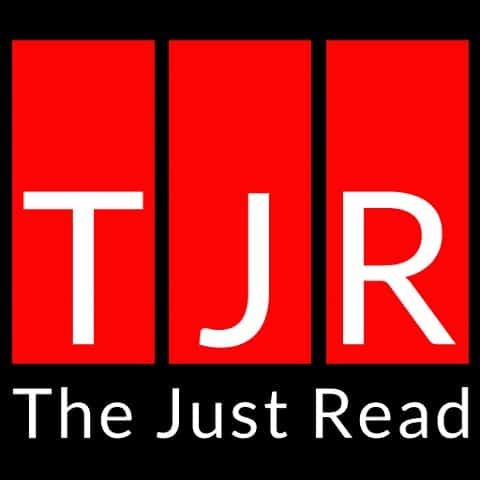
- Lesson Ideas
Teaching Writing Process (With Bonus Powerpoint Lesson Slides)
By Becky F
When we teach the writing process to students, we help them with strategies to become independent and effective writers. The writing process provides a framework for students to write in various genres. It is flexible and allows for creativity and authenticity in writing, but with a few guidelines along the way.
Teaching students the writing process includes the following strategies: planning, research, drafting, revision, editing, and preparation for sharing. Younger students will learn less intensive variations of this process, whereas older students will benefit from the additional steps.
Our aim as teachers is to show students strategies for successful writing. It might seem laborious to include so many steps, but it certainly improves the quality of writing as a form of communication. Then, as students become more independent, they can choose their own strategies for the writing process.
Teaching The Basic Steps Of The Writing Process
Part of our job as teachers is to equip our students to become independent writers . We do this by teaching them the writing process and different strategies that can be used for various purposes.
The number of steps in the writing process will differ according to the age of the students. The basic steps for younger students are planning , drafting , revising , and editing . Older students will learn added steps including research and preparing their writing for sharing.
The planning phase is also called the prewriting phase . During this stage, we teach students to check if they understand the question or task first. Once they know what is expected of them, they can brainstorm ideas and plan the way they will approach the written task.
Research is an offshoot of the planning phase and is usually linked to informative writing projects . Younger students aren't usually required to list their resources. Older students should, however, list their references and be warned against plagiarism and spinning of information .
Once students have gathered the necessary information and ideas, they can write a draft of their written project. A draft helps writers to put their thoughts and ideas in writing , but it is not the final product.
After completing the draft, we teach students to read through it critically . While doing so, they must check if their work reads well and if they should add or omit any information. Depending on the type of project, the students can swap drafts for revision and suggestions, or the teacher can help the students.
If the revision process highlighted any errors or room for improvement, the students must edit their work. Here the students might rewrite sentences or check for spelling or grammatical errors . If the written work is done on a word processor, the editing process will go faster. Alternatively, the students must write out their work in full, with corrections.
The preparation part of the process means getting the edited task ready for sharing . Preparation includes printing the assignment, decorating it, adding images, or publishing it on a specified platform.
The Three Types Of Common Core Writing
Part of teaching the writing process includes teaching students the three types of Common Core Writing Capacities . The writing process for each will be similar, but the style of writing will differ.
The three Common Core Writing capacities include the following:
- Argument . Argument writing is where the writer interprets facts and evidence. Depending on the question or project, the student might have to persuade the reader that their interpretation is correct.
- Informational . As its name suggests, the purpose of this writing is to convey information. Research projects are usually informational.
- Narrative . Narrative writing is creative writing and includes short stories and poetry. Students can write their narratives in the first or third person.
Teaching Tips To Improve The Writing Process
There are other great ways we, as teachers, can encourage our students in their writing projects . These include the following:
- Display a flow diagram with the writing process.
- Expose your students to different genres of writing.
- Display a "vocabulary list" if possible.
- Be current. Include various forms of media and relatable topics into writing projects.
- Encourage students to write from personal experience.
What's Included In Writing Process Lesson Slides?
If you are looking for a complete lesson for teaching Writing Process to your elementary students, here is a valuable teaching resource.
Learning Objectives
Students should:
- understand the writing process
- recognize the steps required to create a good piece of writing
- organize their thoughts using prewriting techniques
Learning Outcomes
Students will be able to:
- express their ideas in the best manner and order possible
- to recognize grammar, spelling, and punctuation errors in their writing
Related: Classroom Lesson: Teaching Literary Elements
You can watch the lesson video here before downloading the slides.
Download ppt Slides For This Lesson
Editable Lesson Slides included
We hope these lesson slides are helpful for you in delivering lessons to your students. You can also check our other Lessons in Teachers Resources .
Please feel free to contact us if you need any specific lessons.
Related Posts
Classroom lesson: teaching cvvc syllable pattern (with powerpoint slides), teaching persuasive writing to elementary (bonus lesson included), teaching generalizations to elementary students (with bonus lesson slides), teaching suffixes to elementary grades ( bonus lesson with activities), subscribe now to get the latest updates.
Classroom Q&A
With larry ferlazzo.
In this EdWeek blog, an experiment in knowledge-gathering, Ferlazzo will address readers’ questions on classroom management, ELL instruction, lesson planning, and other issues facing teachers. Send your questions to [email protected]. Read more from this blog.
Four Strategies for Effective Writing Instruction

- Share article
(This is the first post in a two-part series.)
The new question-of-the-week is:
What is the single most effective instructional strategy you have used to teach writing?
Teaching and learning good writing can be a challenge to educators and students alike.
The topic is no stranger to this column—you can see many previous related posts at Writing Instruction .
But I don’t think any of us can get too much good instructional advice in this area.
Today, Jenny Vo, Michele Morgan, and Joy Hamm share wisdom gained from their teaching experience.
Before I turn over the column to them, though, I’d like to share my favorite tool(s).
Graphic organizers, including writing frames (which are basically more expansive sentence starters) and writing structures (which function more as guides and less as “fill-in-the-blanks”) are critical elements of my writing instruction.
You can see an example of how I incorporate them in my seven-week story-writing unit and in the adaptations I made in it for concurrent teaching.
You might also be interested in The Best Scaffolded Writing Frames For Students .
Now, to today’s guests:
‘Shared Writing’
Jenny Vo earned her B.A. in English from Rice University and her M.Ed. in educational leadership from Lamar University. She has worked with English-learners during all of her 24 years in education and is currently an ESL ISST in Katy ISD in Katy, Texas. Jenny is the president-elect of TexTESOL IV and works to advocate for all ELs:
The single most effective instructional strategy that I have used to teach writing is shared writing. Shared writing is when the teacher and students write collaboratively. In shared writing, the teacher is the primary holder of the pen, even though the process is a collaborative one. The teacher serves as the scribe, while also questioning and prompting the students.
The students engage in discussions with the teacher and their peers on what should be included in the text. Shared writing can be done with the whole class or as a small-group activity.
There are two reasons why I love using shared writing. One, it is a great opportunity for the teacher to model the structures and functions of different types of writing while also weaving in lessons on spelling, punctuation, and grammar.
It is a perfect activity to do at the beginning of the unit for a new genre. Use shared writing to introduce the students to the purpose of the genre. Model the writing process from beginning to end, taking the students from idea generation to planning to drafting to revising to publishing. As you are writing, make sure you refrain from making errors, as you want your finished product to serve as a high-quality model for the students to refer back to as they write independently.
Another reason why I love using shared writing is that it connects the writing process with oral language. As the students co-construct the writing piece with the teacher, they are orally expressing their ideas and listening to the ideas of their classmates. It gives them the opportunity to practice rehearsing what they are going to say before it is written down on paper. Shared writing gives the teacher many opportunities to encourage their quieter or more reluctant students to engage in the discussion with the types of questions the teacher asks.
Writing well is a skill that is developed over time with much practice. Shared writing allows students to engage in the writing process while observing the construction of a high-quality sample. It is a very effective instructional strategy used to teach writing.

‘Four Square’
Michele Morgan has been writing IEPs and behavior plans to help students be more successful for 17 years. She is a national-board-certified teacher, Utah Teacher Fellow with Hope Street Group, and a special education elementary new-teacher specialist with the Granite school district. Follow her @MicheleTMorgan1:
For many students, writing is the most dreaded part of the school day. Writing involves many complex processes that students have to engage in before they produce a product—they must determine what they will write about, they must organize their thoughts into a logical sequence, and they must do the actual writing, whether on a computer or by hand. Still they are not done—they must edit their writing and revise mistakes. With all of that, it’s no wonder that students struggle with writing assignments.
In my years working with elementary special education students, I have found that writing is the most difficult subject to teach. Not only do my students struggle with the writing process, but they often have the added difficulties of not knowing how to spell words and not understanding how to use punctuation correctly. That is why the single most effective strategy I use when teaching writing is the Four Square graphic organizer.
The Four Square instructional strategy was developed in 1999 by Judith S. Gould and Evan Jay Gould. When I first started teaching, a colleague allowed me to borrow the Goulds’ book about using the Four Square method, and I have used it ever since. The Four Square is a graphic organizer that students can make themselves when given a blank sheet of paper. They fold it into four squares and draw a box in the middle of the page. The genius of this instructional strategy is that it can be used by any student, in any grade level, for any writing assignment. These are some of the ways I have used this strategy successfully with my students:
* Writing sentences: Students can write the topic for the sentence in the middle box, and in each square, they can draw pictures of details they want to add to their writing.
* Writing paragraphs: Students write the topic sentence in the middle box. They write a sentence containing a supporting detail in three of the squares and they write a concluding sentence in the last square.
* Writing short essays: Students write what information goes in the topic paragraph in the middle box, then list details to include in supporting paragraphs in the squares.
When I gave students writing assignments, the first thing I had them do was create a Four Square. We did this so often that it became automatic. After filling in the Four Square, they wrote rough drafts by copying their work off of the graphic organizer and into the correct format, either on lined paper or in a Word document. This worked for all of my special education students!
I was able to modify tasks using the Four Square so that all of my students could participate, regardless of their disabilities. Even if they did not know what to write about, they knew how to start the assignment (which is often the hardest part of getting it done!) and they grew to be more confident in their writing abilities.
In addition, when it was time to take the high-stakes state writing tests at the end of the year, this was a strategy my students could use to help them do well on the tests. I was able to give them a sheet of blank paper, and they knew what to do with it. I have used many different curriculum materials and programs to teach writing in the last 16 years, but the Four Square is the one strategy that I have used with every writing assignment, no matter the grade level, because it is so effective.

‘Swift Structures’
Joy Hamm has taught 11 years in a variety of English-language settings, ranging from kindergarten to adult learners. The last few years working with middle and high school Newcomers and completing her M.Ed in TESOL have fostered stronger advocacy in her district and beyond:
A majority of secondary content assessments include open-ended essay questions. Many students falter (not just ELs) because they are unaware of how to quickly organize their thoughts into a cohesive argument. In fact, the WIDA CAN DO Descriptors list level 5 writing proficiency as “organizing details logically and cohesively.” Thus, the most effective cross-curricular secondary writing strategy I use with my intermediate LTELs (long-term English-learners) is what I call “Swift Structures.” This term simply means reading a prompt across any content area and quickly jotting down an outline to organize a strong response.
To implement Swift Structures, begin by displaying a prompt and modeling how to swiftly create a bubble map or outline beginning with a thesis/opinion, then connecting the three main topics, which are each supported by at least three details. Emphasize this is NOT the time for complete sentences, just bulleted words or phrases.
Once the outline is completed, show your ELs how easy it is to plug in transitions, expand the bullets into detailed sentences, and add a brief introduction and conclusion. After modeling and guided practice, set a 5-10 minute timer and have students practice independently. Swift Structures is one of my weekly bell ringers, so students build confidence and skill over time. It is best to start with easy prompts where students have preformed opinions and knowledge in order to focus their attention on the thesis-topics-supporting-details outline, not struggling with the rigor of a content prompt.
Here is one easy prompt example: “Should students be allowed to use their cellphones in class?”
Swift Structure outline:
Thesis - Students should be allowed to use cellphones because (1) higher engagement (2) learning tools/apps (3) gain 21st-century skills
Topic 1. Cellphones create higher engagement in students...
Details A. interactive (Flipgrid, Kahoot)
B. less tempted by distractions
C. teaches responsibility
Topic 2. Furthermore,...access to learning tools...
A. Google Translate description
B. language practice (Duolingo)
C. content tutorials (Kahn Academy)
Topic 3. In addition,...practice 21st-century skills…
Details A. prep for workforce
B. access to information
C. time-management support
This bare-bones outline is like the frame of a house. Get the structure right, and it’s easier to fill in the interior decorating (style, grammar), roof (introduction) and driveway (conclusion). Without the frame, the roof and walls will fall apart, and the reader is left confused by circuitous rubble.
Once LTELs have mastered creating simple Swift Structures in less than 10 minutes, it is time to introduce complex questions similar to prompts found on content assessments or essays. Students need to gain assurance that they can quickly and logically explain and justify their opinions on multiple content essays without freezing under pressure.

Thanks to Jenny, Michele, and Joy for their contributions!
Please feel free to leave a comment with your reactions to the topic or directly to anything that has been said in this post.
Consider contributing a question to be answered in a future post. You can send one to me at [email protected] . When you send it in, let me know if I can use your real name if it’s selected or if you’d prefer remaining anonymous and have a pseudonym in mind.
You can also contact me on Twitter at @Larryferlazzo .
Education Week has published a collection of posts from this blog, along with new material, in an e-book form. It’s titled Classroom Management Q&As: Expert Strategies for Teaching .
Just a reminder; you can subscribe and receive updates from this blog via email (The RSS feed for this blog, and for all Ed Week articles, has been changed by the new redesign—new ones are not yet available). And if you missed any of the highlights from the first nine years of this blog, you can see a categorized list below.
- This Year’s Most Popular Q&A Posts
- Race & Racism in Schools
- School Closures & the Coronavirus Crisis
- Classroom-Management Advice
- Best Ways to Begin the School Year
- Best Ways to End the School Year
- Student Motivation & Social-Emotional Learning
- Implementing the Common Core
- Facing Gender Challenges in Education
- Teaching Social Studies
- Cooperative & Collaborative Learning
- Using Tech in the Classroom
- Student Voices
- Parent Engagement in Schools
- Teaching English-Language Learners
- Reading Instruction
- Writing Instruction
- Education Policy Issues
- Differentiating Instruction
- Math Instruction
- Science Instruction
- Advice for New Teachers
- Author Interviews
- Entering the Teaching Profession
- The Inclusive Classroom
- Learning & the Brain
- Administrator Leadership
- Teacher Leadership
- Relationships in Schools
- Professional Development
- Instructional Strategies
- Best of Classroom Q&A
- Professional Collaboration
- Classroom Organization
- Mistakes in Education
- Project-Based Learning
I am also creating a Twitter list including all contributors to this column .
The opinions expressed in Classroom Q&A With Larry Ferlazzo are strictly those of the author(s) and do not reflect the opinions or endorsement of Editorial Projects in Education, or any of its publications.
Sign Up for EdWeek Update
Edweek top school jobs.

Sign Up & Sign In


- Career Center
Position Statements
- Submit a Resolution
- All Position Statements
- NCTE Process for Adopting Official Guidelines and Short Documents
Understanding and Teaching Writing: Guiding Principles
This statement, formerly known as Teaching Composition: A Position Statement (1985), was revised in November 2018 with the new title Understanding and Teaching Writing: Guiding Principles.
The statement is organized into three sections that outline, in broad strokes, what the research literature tells us about writing and the teaching of writing. Each section of this statement provides a brief definition of principles for understanding and teaching writing and provides resources for additional information. The statement concludes with implications for teachers of writing (and writers) based on the principles.
Part 1: What Is “Writing”?
“Writing” refers to the act of creating composed knowledge. Composition takes place across a range of contexts and for a variety of purposes. A writer might compose a blog entry to share news about an important event to an audience of readers whom she has never seen; alternatively, she might write about this event for herself in a private notebook that only she reads. A student might compose a series of equations to think through a difficult mathematical problem for herself as part of an exam; the same student might compose these equations in a lab notebook for others to understand a complex reaction. A community might collaboratively compose a document to convey their position on an issue, like this statement; other writers might use collaboratively composed documents to create their own compositions. As composed knowledge, writing thus serves multiple purposes: to help writers develop and document their ideas for a range of purposes and audiences in a variety of contexts; to distribute ideas to other audiences so that they can be revised or recirculated; to help an individual or a community to define, clarify, or even reify its ideas. As composed knowledge, “writing” ranges broadly from written language (such as that used in this statement), to graphics, to mathematical notation.
The focus of this statement is on teaching written language to students, largely in school, from pre-kindergarten through graduate school. This document outlines a set of principles for the teaching of writing—of composed knowledge. While teaching is conventionally associated with classroom or school settings, this statement acknowledges that teaching and learning happen across the range of a learner’s experience—in school and in the classroom, but also at home, in their communities, with colleagues and friends. As a document intended for use primarily (but not exclusively) by formal educators, the principles here may serve to guide courses, assignments, activities, and work with writers and writing (or composed knowledge) within and beyond the formalized curriculum.
Principle 1.1: Writing is social and rhetorical.
The first parts of this principle—writing is social and rhetorical—focus on external factors and writing (Roozen). Writing is produced by people, in specific situations and contexts, and often (but not always) circulates among people. Writing is thus social—it is intended to speak to audiences for particular purposes. Even when a writer writes “for themselves” (e.g., in a personal blog or diary), they are their own audience (Bawarshi). When it is effective, writing is rhetorical, i.e., it takes into account the values, ideologies, interests, needs, and commitments of the people, the audiences, for whom it is intended.
When writers produce writing, they take into consideration purposes, audiences, and contexts. This leads them to make intentional choices about the elements that go into writing:
- content (the subject or focus of the writing);
- form (the shape of the writing, including its organization, structure, flow, and composition elements like words, symbols, images, etc.);
- style/register (the choice of discourse and syntax used for the writing, chosen from among the vast array of language systems [often called “dialects”] that are available for the writer); and mechanics (punctuation, citational style, etc.).
When writing reflects the expectations that audiences have for each of these elements, it is considered good; when it does not, it is considered less than good—and often the writers who produce it are judged accordingly.
Principle 1.2: Writing serves a variety of purposes.
Writing can serve a wide variety of purposes, and it happens in and out of school, as well. Sometimes, writing can be utilitarian: it is produced to achieve a specific purpose that can be quite disassociated from the writers’ identity or ideas—for instance, a manual for how to operate a digital projector. At other times, writing can be enormously personal, as when a writer is composing a document—film, poem, rap—that reflects deeply held beliefs or ideas. In each of these instances and regardless of purpose, what writers produce reflects their own assessment of the purpose, audience, context, and value of the writing—for themselves and/or for others.
Importantly, writing happens far beyond the walls of a classroom or school—and for school-aged writers, lately more often out of school than in (Applebee and Langer; Lenhart et al). When writers compose—texts to friends, Instagram posts, fan fiction, blogs, or any one of a myriad of sites where they can create identities—they are writing. However, writers increasingly do not recognize these acts as writing, seeing them as distinct from what they are asked to do in school (Lenhart et al). There, analyses have shown that when writing is taught, it is often linked to standards or expectations that writers perceive to be slightly removed or even quite distinct from their experiences, identities, and interests.

Part 2: Who Are Writers?
In teaching writing, it is important to understand who writers are. Students must learn how writing works, and to help them achieve this, recognizing who writers are is essential. Four principles provide an overview of characteristics and concepts that contribute to the formation and development of writers.
Principle 2.1: Everyone is a writer.
Everyone has the capacity to write. Writers are not static. They develop skills and enhance their writing skills throughout their writing lives; thus, writers grow continually. Becoming a better writer requires practice. The more writers write, the more familiar it becomes. As writers, sometimes they feel confident; at other times, they may feel afraid and insecure. Therefore, students learn to write by writing.
Writers can be beginning or advanced writers in different situations. Just because they may be advanced in one situation, it does not make them advanced in all situations. Writers are researchers too, and they should develop the critical ability to evaluate their own work. They may collaborate with each other in different stages of writing, from drafting to revision to publication. Thus, writers learn how writing is a social act when they consider audiences and contexts and when they work with other writers as they compose.
Writers have varied experiences. They employ different strategies when composing in different situations, for different purposes and audiences, and when using different technologies and tools. Writers also make ethical choices, and writers always have more to learn.
Principle 2.2: Writers bring multiliteracies, and they bring cultural and linguistic assets to whatever they do.
Because writing is linked to identity, writers represent different ideologies, values, and identities. Thus, writers’ cultures and languages influence their writing. Recognizing that students are language users with multiple literacies will help the writing instructor engage students in writing. Writers also bring their past writing and reading practices with them whenever they write or read. In short, everything they have experienced, who they are, where they have been, and what they have done impact their writing practices, literacies, and language attitudes.
Second-language, or multilingual, writers have become an integral part of writing courses and programs. They take part in these courses and programs at all grades (K–graduate level) and content areas. The language practices and linguistic backgrounds vary among these writers; thus, these writers should not be treated as one and the same. For example, some second-language writers may be native speakers of languages without ever having to learn and practice the written form of such languages. This may include their first language.
Because discourse, audience, and rhetorical appeals often differ across cultural, linguistic, and educational contexts, second-language writers may find it difficult to understand and/or apply the discursive strategies taught in a US writing classroom. Thus, second-language writers’ literacy and linguistic practices should be valued and recognized as assets in the writing classroom and not be viewed as weaknesses and as language interference problems. On the contrary, instructors should identify the strengths second-language writers bring to the classroom and seek opportunities to use these writers’ literacy and linguistic practices as a foundation.
Principle 2.3: Writers compose using different modes and technologies.
With 21st-century technologies, writers compose both print and digital texts. As technologies become more advanced and sophisticated, writers learn the possibilities afforded by these tools. They learn about the potential that various technologies have for the production, consumption, and distribution of forms of composed knowledge. This includes not only writing, but also the composition of other types of texts, such as videos and podcasts. Thus, writers may compose multimodal and digital texts.
With technology, writers are now engaged in multiple discourses, such as texting, blogging, posting on social media sites, and instant messaging, thus using language and writing on a daily basis. It is crucial for writers to be exposed to and gain access to a wide range of technologies and tools and learn about the possibilities of composing with them.
Principle 2.4: Writers compose in and outside the classroom.
Because writing takes place in different contexts, writers compose for different readers, with varied purposes, and in diverse situations and places. Writers should develop the critical ability to evaluate their own work so that they can become effective, independent writers in the world beyond school. Writers grow by envisioning and learning to write for a variety of audiences. They reflect on the readers’ needs within particular social contexts, often including the readers’ values. As such, writers may engage with their communities and make their writing and composing public. Thus, writers may compose about, with, and for their communities.
Part 3: Essential Principles for Teaching Writing
As teachers of writers, our goal is for writers to emerge as better writers with each new writing experience. This means that as teachers we must consider how writers learn and how we can create conditions in our classroom so that learning can take place. The following four principles can help teachers as we lead classroom communities of writers, as we design curricula and instruction, as we assess learning and evaluate students’ performance, and as we inquire and talk with one another about what we are learning from our experience of leading individual writers and groups of writers. In the principles below, we use the metaphor of “grow” to remind us of our overarching goal of writers emerging from each writing experience with a better understanding of writing, with a clearer sense of who they are as writers, and with a refined and expanded repertoire of conceptual and practical tools that allows them to see possibilities and choices in their future writing experiences.
Principle 3.1: Writers grow within a context / culture / community of feedback.
To emerge as better writers from a writing experience, learners need feedback, and this feedback should fuel revision. In a community of feedback, teachers become learners too, because they inquire with learners about why writers make the choices they do. In a community of feedback, teachers and writers talk together about both products and processes, which means they share criteria, discuss challenges and choices, and offer feedback on how helpful feedback is in helping writers see new possibilities and options in steps they might take next.
Principle 3.2: Writers grow when they broaden their repertoire, and when they refine their judgment in making choices with their repertoire.
Writers need models and strategies—to find topics, issues, and questions to write about, to revise, to contextualize and connect their piece with others, to give and receive feedback. However, collecting those strategies is not enough; writers need practice not only in choosing a strategy to fit a particular purpose and context, but they also need practice in explaining why they made the choices they did.
Principle 3.3: Assessment should be transparent and contextual, and it should provide opportunities for writers to take risks and grow.
Writers need assessments that make audiences, purposes, and expectations clear, and they need multiple opportunities to practice meeting those criteria. When writers have multiple opportunities to practice, to try something new, to take risks or make mistakes, they know that not every writing experience is a high-stakes or evaluative one. For teachers of writers, this means that we can liken the practice of assessment to driving a car—we will see some fixed data (e.g., fuel tank, odometer, speedometer), and we will see some contextual data (what other cars are doing, road conditions, weather conditions). As drivers, we make decisions based on both kinds of data, and the same idea holds true for both writers and teachers of writers. The assessment tools and the way teachers use them create a set of values and purposes in which student writers respond to their experiences of trying to improve as writers. Thus, assessment provides opportunities and occasions for writers to know where they might be headed in a piece of writing.
Principle 3.4: Writers grow when they have a range of writing experiences and in-depth writing experiences.
In practice, writers need to write for multiple purposes, audiences, and contexts. When learners have a range of writing experiences, it offers opportunities for them to make choices, to self-assess, and to reflect on the wisdom of those choices they make as the write for those different purposes, audiences, and contexts. When learners have in-depth writing experiences, they have opportunities to spend time, work from multiple drafts, and see how their writing and thinking have changed over time. In both broad and deep writing experiences, writers grow when they have opportunities to expand upon—and not merely transmit—content knowledge.
Suggested Resources and Readings
Adler-Kassner, Linda, and Elizabeth Wardle, editors. Naming What We Know: Threshold Concepts in Writing Studies. Utah State UP, 2015.
Anson, Ian G., and Chris M. Anson. “Assessing Peer and Instructor Response to Writing: A Corpus Analysis from an Expert Survey.” Assessing Writing, vol. 33 , 2017, pp. 12–24.
Applebee, Arthur, and Judith Langer. The State of Writing Instruction in America’s Schools: What Existing Data Tell Us . Albany, NY: Center on English Learning and Achievement, 2006.
Baca, Isabel, Yndalecio Isaac Hinojosa, and Susan Wolff-Murphy. Bordered Writers: Latinx Identities and Literacy Practices at Hispanic-Serving Institutions. SUNY Press, forthcoming 2019.
Bawarshi, Anis. Genre and the Invention of the Writer . Utah State UP, 2003.
Bruce, Shanti, and Ben Rafoth, editors. ESL Writers: A Guide for Writing Center Tutors. 2nd ed., Boynton/Cook Heinemann, 2009.
CCCC Position Statement on Community-Engaged Projects in Rhetoric and Composition. Conference on College Composition and Communication, April 2016, http://cccc.ncte.org/cccc/resources/positions/community-engaged .
CCCC Position Statement on Students’ Right to Their Own Language. Conference on College Composition and Communication, November 2014, https://www2.ncte.org/statement/secondlangwriting/ .
Cox, Michelle, Jay Jordan, Christina Ortmeier-Hooper, and Gwen Gray Schwartz, editors. Reinventing Identities in Second Language Writing. NCTE, 2010.
Deans, Thomas, Barbara Roswell, and Adrian J. Wurr, editors. Writing and Community Engagement: A Critical Sourcebook. Bedford/St. Martin’s, 2010.
Drew, Sally Valentino, Natalie G. Olinghouse, Michael Faggella-Luby, and Megan E. Welsh. “Framework for Disciplinary Writing in Science Grades 6–12: A National Survey.” Journal of Educational Psychology , vol. 109, no. 7, 2017, pp. 935–955.
Fidalgo, Raquel, Mark Torrance, Gert Rijlaarsdam, Huub van den Bergh, and M. Lourdes Alvarez. “Strategy-Focused Writing Instruction: Just Observing and Reflecting on a Model Benefits 6th Grade Students.” Contemporary Educational Psychology, vol. 41, 2015, pp. 37–50.
Foltz, P. W., K. E. Lochbaum, and M. B. Rosenstein. “Analysis of Student ELA Writing Performance for a Large Scale Implementation of Formative Assessment.” In Annual Meeting of the National Council for Measurement in Education , New Orleans, LA. 2011.
Grabill, Jeffrey T. Writing Community Change: Designing Technologies for Citizen Action. Hampton Press, 2007.
Hattie, John, and Helen Timperley. “The Power of Feedback.” Review of Educational Research , vol. 77, no. 1, 2007, pp. 81–112.
Horner, Bruce, Min-Zhan Lu, and Paul Kei Matsuda, editors. Cross-Language Relations in Composition. Southern Illinois UP, 2010.
Jeffery, Jill V., and Kristen Wilcox. “‘How Do I Do It if I Don’t Like Writing?’: Adolescents’ Stances toward Writing across Disciplines.” Reading and Writing, vol. 27, no. 6, 2014, pp. 1095–1117.
Kellogg, Ronald T., and Alison P. Whiteford. “Training Advanced Writing Skills: The Case for Deliberate Practice.” Educational Psychologist, vol. 44, no. 4, 2009, pp. 250–266.
Kirklighter, Cristina, Diana Cardenas, and Susan Wolff-Murphy, editors. Teaching Writing with Latino/a Students: Lessons Learned at Hispanic Serving Institutions . SUNY Press, 2007.
Koster, Monica, Elena Tribushinina, Peter F. de Jong, and Huub van den Bergh. (2015). “Teaching Children to Write: A Meta-analysis of Writing Intervention Research.” Journal of Writing Research, vol. 7, no. 2, 2015, pp. 299–324.
Lenhart, Amanda, et al. Writing, Technology, and Teens . Pew Internet and American Life Project, 2008.
Moore, Jessie L., et al. “Revisualizing Composition: How First-Year Writers Use Composing Technologies.” Computers and Composition , vol. 39, 2016, pp. 1–13.
NCTE Definition of 21st Century Literacies. National Council of Teachers of English, February 2013, https://www2.ncte.org/statement/21stcentdefinition/ .
NCTE Position Statement on Professional Knowledge for the Teaching of Writing. National Council of Teachers of English, February 2016, https://www2.ncte.org/statement/teaching-writing/ .
Parks, Steve. Writing Communities: A Handbook with Readings. Bedford/St. Martin’s, 2017.
Philippakos, Zoi A., and Charles A. MacArthur. “The Effects of Giving Feedback on the Persuasive Writing of Fourth- and Fifth-Grade Students.” Reading Research Quarterly, vol. 51, no. 4, 2016, pp. 419–433.
Ray, Amber B., Steve Graham, Julia D. Houston, and Karen R. Harris. “Teachers’ Use of Writing to Support Students’ Learning in Middle School: A National Survey in the United States.” Reading and Writing, vol. 29, no. 5, 2016, pp. 1039–1068.
Roozen, Kevin. “Writing is a Social and Rhetorical Activity.” Naming What We Know: Threshold Concepts of Writing Studies , edited by Linda Adler-Kassner and Elizabeth Wardle, Utah State UP, 2015, pp. 17–19.
Ryan, Mary E. “Reflexive Writers: Re-thinking Writing Development and Assessment in Schools.” Assessing Writing, vol. 22, 2014, pp. 60–74.
Stock, Patricia L., editor. Composition’s Roots in English Education. Heinemann, 2011.
Yancey, Kathleen Blake, Liana Robertson, and Kara Taczak, editors. Writing Across Contexts: Transfer, Composition, and Sites of Writing. Utah State UP, 2014.
Statement Authors
This document was revised by an NCTE working committee comprising the following:
Linda Adler-Kassner, University of California Santa Barbara
Isabel Baca, University of Texas–El Paso
Jim Fredricksen, Boise State University
This position statement may be printed, copied, and disseminated without permission from NCTE.
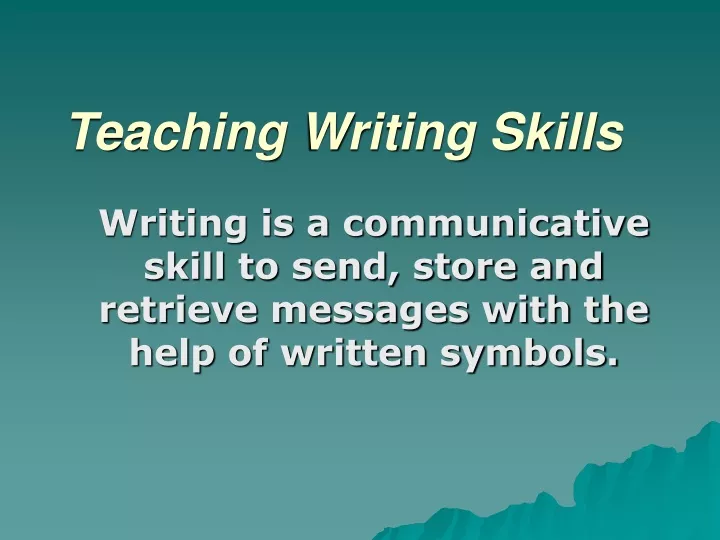
Teaching Writing Skills
Jan 05, 2020
240 likes | 1.09k Views
Teaching Writing Skills. Writing is a communicative skill to send, store and retrieve messages with the help of written symbols. Characteristics of Written Language. Permanence Production time Distance Orthography Complexity Vocabulary Formality. Microskills for Writing.
Share Presentation
- produce writing
- writing strategies
- authentic writing
- real writing
- teaching writing skills

Presentation Transcript
Teaching Writing Skills Writing is a communicative skill to send, store and retrieve messages with the help of written symbols.
Characteristics of Written Language • Permanence • Production time • Distance • Orthography • Complexity • Vocabulary • Formality
Microskills for Writing Some are as follows: • Produce graphemes and orthographic patterns of English • Produce writing at an efficient rate of speed to suit the purpose • Produce an acceptable core of words and use appropriate word orderpatterns • Use acceptable grammatical systems, patterns, and rules • Express a particular meaning in diff. grammatical forms • Use cohesive devices in written discourse • Use the rhetorical forms and conventions of written discourse • Appropriately accomplish the communicative functions of written texts • Distinguish between literal and implied meanings when writing • Develop and use a battery of writing strategies.
Principles for Designing Writing Techniques • Incorporate practices of "good" writers • Account for cultural/literary backgrounds • Connect reading and writing • Provide as much authentic writing as possible • Frame your techniques in terms of prewriting, drafting, and revising stages
Types of Classroom Writing Performance • Imitative or writing down • Intensive or controlled • Self-writing • Display writing • Real writing • Academic • Vocational/technical • Personal
Some Writing (Practice) Activities • Sentences • Short reports and descriptions • Linking words • Text completion • Flowcharts • Pictures
- More by User
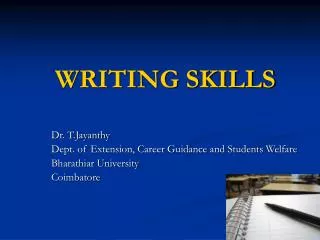
WRITING SKILLS
WRITING SKILLS. Dr. T.Jayanthy Dept. of Extension, Career Guidance and Students Welfare Bharathiar University Coimbatore. BASICS OF WRITING . Decide on your topic. Prepare an outline or diagram of your ideas. Write your thesis statement. Write the body. . WRITING.
1.28k views • 28 slides
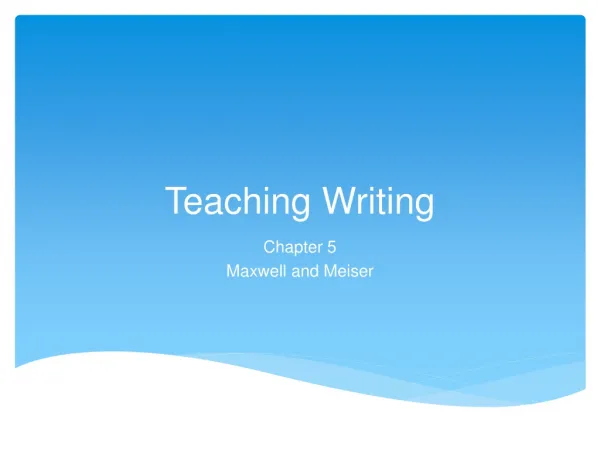
Teaching Writing
Teaching Writing. Chapter 5 Maxwell and Meiser. Research Issues. Writing in other subjects Grading Skills vs content Choosing topics of interest. Across the years. 1930s - motivation, relevance, errors 1940s - topics of interest 1950s - errors and basics
740 views • 16 slides

Writing Skills
Writing Skills. Personal Writing A Workshop for 4 th Grade. With a focus on Personal Narratives. L. Rozelle, Winter 2010. What is Personal Writing?. Personal writing is when you write about yourself and express your own thoughts and opinions.
658 views • 34 slides

WRITING SKILLS. TECHNICAL SKILLS. Writing Style. 1. 2. IRAC. Structure of a memorial. 3. 4. Writing process. Word processing. 5. Citation. 6. BEFORE WRITING. OBJECTIVE. Win the case. Win the competition. or. BEFORE WRITING. STRUCTURE. Content. Format. and. WRITING STYLE.
860 views • 35 slides

Writing Skills. The Purpose of Writing Writing is a Product, used to disseminate research results Writing is a Process which helps us derive research results
548 views • 24 slides

WRITING SKILLS. FORMAL AND INFORMAL Styles. FORMAL STYLE IS APPROPRIATE. INFORMAL STYLE IS APPRPOPRIATE. A composition A report A letter to somebody you do not know personally A story. A letter to your friend An article for your school magazine Direct speech in a story.
1.15k views • 17 slides
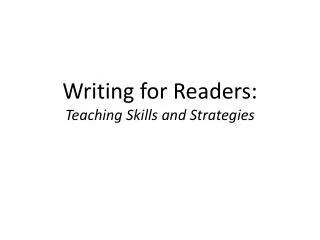
Writing for Readers: Teaching Skills and Strategies
Writing for Readers: Teaching Skills and Strategies. Prior to now we have:. Reveled in approximations Hidden our struggles to translate Done anything to avoid the fact that the students work is unreadable. PART ONE: Inspiring Children to Write for Readers. Let students in on the “ secrect ”
268 views • 19 slides

Writing Skills. Tips to help you improve your writing and be successful on the OSSLT!. Supported Opinion Paragraphs.
595 views • 17 slides

Writing Skills. Progress Made & The Final Essay. Progress. Thesis Statements placed correctly in introductions Thesis phrasings are improved Provide a general argument Provides an outline of essay Supportive Quotes and evidence are relevant Following Thesis arguments THROUGHOUT essay
253 views • 6 slides

Writing Skills. Reasons Why The English Language Is Hard To Learn . We must polish the Polish furniture. He could lead if he would get the lead out. The soldier decided to desert his dessert in the desert.
566 views • 28 slides

TEACHING WRITING
TEACHING WRITING. SEMINAR. BY I Gusti Ayu Ngurah Lesmana Dewi NPM : 08.8.03.51.31.2.5.2773 CLASS : VIH. ENGLISH DEPARTMENT THE FACULTY OF TEACHER TRAINING AND EDUCATION MAHASARASWATI UNIVERSITY DENPASAR 2011. TABLE OF CONTENTS. INTRODUCTION. WHAT DO WE MEAN BY WRITING SKILLS?.
470 views • 10 slides

Writing Skills. Effective Written Communications are Important. Provides a permanent record of discussions Important communications link Way of life in modern organizations. The one thing that most of us do better than anyone else is read our own writing. The Fog Index.
936 views • 8 slides

WRITING SKILLS. OVERVIEW. WRITING SKILL By the end of the six year primary schooling, pupils will be able to: express their ideas clearly on paper in legible handwriting or to communicate via the electronic media.
941 views • 38 slides

Writing Skills. Write correctly right now!. When reading the prompt, what technique should you use to help you decide what to write?. FATP ARCH RAFT RAFTS. In RAFTS, what does the “R” signify?. Read Reader Role Revise. In RAFTS, what does the “A” symbolize?. Audience Author
676 views • 32 slides

Writing skills
Writing skills. Blog 1: Banking. Assignment. Write a blog entry on the group blog that your teacher created The blog entry should be exactly four sentences long and deal with the topic of banking in general The goal is to consider flow when writing texts Deadline 15 October.
414 views • 12 slides

Writing Skills. “Writing skills are best learned through experience – through doing.” William Strong, author of Sentence Combining, a Composing Book. Sentence Combining in Action. Look at these short, choppy sentences. The sub had faked to the baseline.
761 views • 20 slides

Writing Skills. Topics. Coherence Peer Review Mechanics. Telling the Story Paragraph and Essay Coherence One topic per paragraph Logical transitions between sentences and paragraphs Topic sentences Organization and The Use of Headings. Peer Review.
410 views • 24 slides
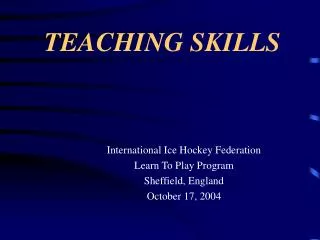
TEACHING SKILLS
TEACHING SKILLS. International Ice Hockey Federation Learn To Play Program Sheffield, England October 17, 2004. “Hockey Is Not Rocket Science. It’s Not All X’s and O’s and Positioning and Systems. The Team With the Best Skills Are Usually Going to Win.”.
535 views • 26 slides

Writing Skills. PDP Research – Social Science Ms. Goggins. Parts of an Essay. Introduction Opening Statement Context Roadmap Thesis Supporting Body Paragraph 1 Main Idea Evidence Analysis Tie back to Thesis Supporting Body Paragraph 2 Supporting Body Paragraph 3 Conclusion
490 views • 23 slides

Writing Skills. POLAND ppor. Agata Młynik. What is needed for good writing skills ?. Eays Hearing Motoric. proper development - critical periods the respective functions must appear in the appropriate age. Eays.
339 views • 13 slides

Writing Skills. Boğazıçı University May 6, 2004 Tom Atkinson. Feedback. What you liked Topic useful Verbal presentation engaging What you didn’t like Too fast Slides boring, not helpful. Agenda. Writing an Email Motivation What makes a good email Writing a Report Planning
926 views • 68 slides

Writing Skills. -- n IKHIL j OSHI [email protected] [email protected] www.nikhiljoshi2007.blogspot.com www.gcet-languageclub.blogspot.com www.communicationandresearchskills.blogspot.com.
537 views • 12 slides
- Teaching secondary
- Teaching tools
Teaching writing
From task preparation to a suggested correction code, our Teaching writing poster gives you lots of ideas to use in the classroom.

You can download this useful poster below.
Inquiry about the Teaching Writing Course
Dear Teaching English Team,
Is there any chance to share the course Teaching Writing again?
Thanks in Advance
- Log in or register to post comments
Teaching Writing course
Thanks for your comment - our Teaching Writing course will run again in August / September of this year. You can find out more about the course here: https://www.teachingenglish.org.uk/training/teachingenglish-how-teach-writing and also access the participant workbook.
Hope that helps,
TeachingEnglish team
I think you should try to know about writting skills and it has more way to be creative writer and that s individual skill and this is different from teacher to other
teaching writing
It's a wonderful tip to of providing the students with scrap papers to present the idea of each individual in the classroom. The shy students will also feel confident in writing their own topic.
Research and insight
Browse fascinating case studies, research papers, publications and books by researchers and ELT experts from around the world.
See our publications, research and insight
(SIMS Code: 112299)
Offered by the Department of Rhetoric and Writing Studies, the Advanced Certificate in the Teaching of Writing provides opportunities for teachers, scholars, and other professionals to expand their knowledge of rhetoric, expository texts, and composition instruction.
Applicants to the program must have completed a bachelor’s degree from an accredited institution.
Students in the program must complete 12 units of coursework with a minimum of six units at the 600-level or above. A minimum grade point average of 3.0 or better must be maintained in certificate coursework, with no less than a C grade in any course.
The certificate adviser in the Department of Rhetoric and Writing Studies is responsible for evaluating applications and advising students.
Up to 12 units of coursework taken as part of the certificate program, with the approval of the graduate adviser, may be applied to the Master of Arts degree in rhetoric and writing studies with a specialization in the teaching of writing.
Required Courses (6 Units)
- RWS 600 - Reading and Writing Rhetorically Units: 3
- RWS 509 - Teaching Composition in Secondary Schools Units: 3
- RWS 609 - Theory and Practice of Teaching Composition Units: 3 But not both.
Electives (6 Units)
Three units selected from.
- LING 550 - Theory and Practice of English as a Second Language Units: 3
- LING 652 - Second Language Acquisition Units: 3
- LING 653 - ESL Reading and Writing Units: 3
- RWS 512 - Writing Center Practice, Research, and Theory Units: 3
- RWS 601A - History of Rhetoric I Units: 3
- RWS 602 - Modern Rhetoric and Composition Studies Units: 3
- RWS 640 - Research Methods in Rhetoric and Writing Studies Units: 3
All Activities
Main navigation, searching for beam (background, exhibit, argument, and method) to guide research, jumbo ‘spectra’ worksheets for narrowing topics and locating positions, “is your opening line ‘in a world...'”, presentation genre game, writing to imagine what is possible, tic recipe (layer b - ideation and development series), tic playlist (layer c - ideation and development series), tic peer review on canvas, tic idea map, thinking through storyboards, tell us telos, telling the story of style, take a stand impromptu presentation, synthesis brainstorm, "student choice" genre/modes assignment, the speech-bite, "so much depends on a red wheelbarrow", six degrees of separation, rhetorical mad libs, rhetorical architecture, rhetorical analysis thesis workshops, rhetorical analysis choice board, reverse outlining lunsford presentations, return to the library: research field trip, research topic brainstorm, "research refresher:" virtual scavenger hunt, research question generator with padlet, research proposal planning table, research journal, research challenge presentation, the reflexivity memo: developing student researcher identity through writing, reaching in to reach out to skeptical readers, q&a showcase and live symposium, punctilious rhetorical enterprise situation regarding grandiloquent communication (aka an exercise to help students avoid stuffy writing), professional email activity, preparing for the rhetorical analysis, preparing for the library workshop, places and spaces introductions, pen, crayon, smartphone: exploring how materials shape content and writing practice, oral reflection, oral delivery of research post-rehearsal assignment, online research mixer, online proposal rehearsals, moving beyond ‘transition words’, mining reading, mini-zines for rba structure, metonyms and lenses – focusing your research, mapping intellectual trust, mapping the conversation, the linguistic experiment - how words do things, library research and zotero (video), library game, topic sentences and coherence, translating for analysis, tweeting your tic, two (mini) stories about your name, types of argument, ventriloquy, video screening and small group discussion, voice warm-up, "we shall overcome" delivery activity, what we learned in pwr1, learning style with clickers, introduce yourself, interactive rba preliminary research blog, infographic assignment, infinite canvas – visualizing the argument, impromptu presentation–newspaper translation activity, identifying warrants or assumptions, the hup activity, how to create “energy” in persuasive writing, history of the future, helping students make the most of library days, graduation speech, from google to academic search premiere, global rba review, exquisite corpse topic narrowing activity, evolving your ra argument, everyone loves revision, the empath, the sweetheart, and the skeptic, embodied rhetoric in online presentations, elevator pitch with peer response, the elevator pitch, degrees of quotation, decolonizing the calendar, cultural artifact introduction, crowd sourcing ideas for research topics and paths, crossing the line, revisited, cross-section dress rehearsals, creating emphasis, crafting insightful research questions, copy & compose, conclusions workshop or effective conclusions: the white whale, collaborative invention: working with research topics, collaborative design analysis activity, channeling the doubter and believer, building empathy with spent, bringing story iq to academic writing, bringing cultural rhetorics into the classroom, bridging story and research, beyond tolerant - revise and decolonize, asynchronous pwr 2 draft workshop, async peer review, assessing sources with strategic reading, the art of the ethical interview, the art of reflection, argument as conversation, analyzing viral videos, analyzing the rhetoric of newspaper advertisements, analyzing mode, medium, and message, addressing audience, activity showcase: icebreakers, accordion prewrite, 1-minute screencasting activity, “scholars’ scholarship” and “the scholars converse”, psychic distance, honing topic sentences.
Annual skilled trades competition builds technical and professional skills for Iowa students
- Wednesday, May 1, 2024
- Headline Story
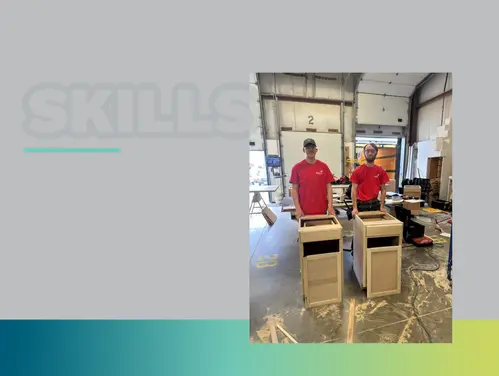
Southeast Polk senior Simon Frohock (R) competed in the cabinet making contest for a second year.
High-quality career and professional skill development took center stage last week as over 600 high school and college students took part in the annual SkillsUSA State Leadership and Skills Conference . Held in Ankeny at the Des Moines Area Community College campus, this two-day competition featured over 50 different leadership and technical competitions for students to test their technical skills and knowledge, explore career pathways and make valuable connections with local industry leaders.

Southeast Polk High School seniors Delvis Kouete and Simon Frohock, both 17, were well-prepared for the competition, which featured timed activities related to industrial technology, carpentry, robotics, automotive repair and job interview techniques, among many others. For this year’s skills competition, Delvis competed in architectural drafting and was a member of the school’s quiz bowl team. Simon, the 2023 state champion in cabinet making, returned for a second year in the cabinet making contest. Both students competed well in their individual competitions, with Delvis placing fifth and Simon serving as this year’s runner-up.
“The skills competition can help you strive for excellence in your work and learning,” Simon said. “Even though it’s a competition and there is pressure to do well, it’s a good, low-risk way to see what an employee in this work has to do every day.”
Both Simon and Delvis noted that the competition not only helps to strengthen a student’s technical skills, but it also engages students in career pathway discovery and professional skill development.
“Being a part of SkillsUSA and competing in the skills competition has helped me learn new skills with my hands and work on teamwork, communication and leadership skills,” Delvis said. “You learn how to work with other people that aren’t like you and get your mind thinking about your future career.”
Along with the individual contests, all competitors at the SkillsUSA State Leadership and Skills Conference were required to submit a resume and take a professional development test that focused on workplace, professional and technical skills as well as overall knowledge of SkillsUSA.
“SkillsUSA helps provide real-world context to the content being taught by classroom educators,” said Kent Storm, state director for SkillsUSA Iowa. “Taking the learning beyond the classroom allows students to grow and learn next to industry partners and gain valuable experience."
As one of Iowa’s career and technical student organizations (CTSO) , SkillsUSA champions the skilled trades industry and provides opportunities for students to apply the skills they have developed in classrooms through conferences, competitions, community service events, worksite visits and other activities.
“Participation in a CTSO like SkillsUSA helps students gain hands-on experience and connect classroom curricula to careers,” said Cale Hutchings, education consultant at the Iowa Department of Education. “Through CTSOs, students can become leaders and strengthen their employability skills, which is valuable as they explore potential next steps in their college and career pathways.”
SkillsUSA boasts a roster of over 400,000 members nationwide. In Iowa, over 1,300 students and advisers in career and technical education programs participate in local SkillsUSA chapters.
At Southeast Polk, 21 student members are a part of their SkillsUSA chapter. Led by industrial technology teachers and chapter advisers Ryan Andersen and Brett Rickabaugh, the students have been involved with several community service projects, employer presentations and opportunities to work closely with instructors.
“Any time a student participates in SkillsUSA, it gives us more time with that student to elaborate on what we’ve learned in class,” Andersen said. “They can connect the idea to the planning, design and completion of a project and how that activity fits into a real career. That’s something we can’t replicate without a CTSO.”
Anderson also stated that students who participate in SkillsUSA and activities like the State Leadership and Skills Conference build confidence through their experiences.
“It really helps students to have the confidence to rely on their skills and what they know,” he said. “The skills competition requires them to use problem-solving skills and build off their knowledge to continue to learn and persevere.”
This year’s first-place winners at the SkillsUSA State Leadership and Skills Conference will move onward to compete with 6,000 other students at the national conference in Atlanta this June.
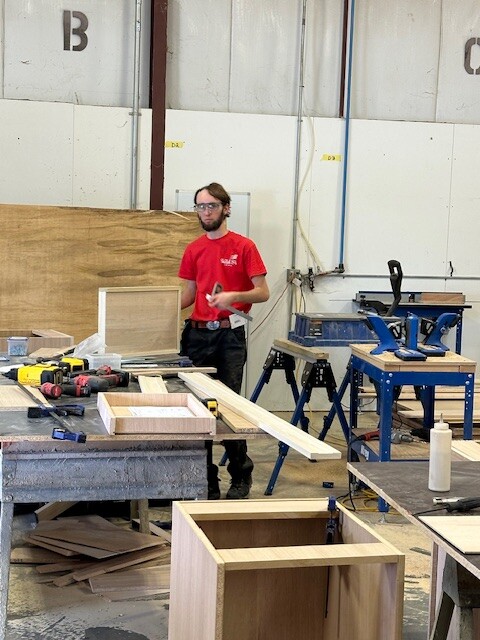
For Simon and Delvis, the skills competition was another step in building necessary skills and acumen for their futures. Simon, with his penchant for cabinet making, already has a full-time job lined up after graduation with a local cabinet shop. Additionally, Delvis would like to pursue something within the computer science field, perhaps in the coding or software engineering areas, and although he is changing fields, he believes SkillsUSA has helped him feel more prepared for the future.
“It has definitely helped me with skill-building and problem-solving,” he said. “What I’ve learned will be beneficial no matter what I decide to do next.”
The annual Undergraduate Thesis Symposium was a resounding success

Last week (04/24) we hosted the annual Undergraduate Thesis Symposium, where 39 of our senior concentrators presented their research to peers, faculty, and junior concentrators interested in writing a dissertation.
Held at CGIS Fisher Family Commons, the well-attended event saw a wide range of topics and presentations, from contemporary American politics – such as “Teach Me Why and How to Vote, Then I’ll Vote! The Effects of High School Voter Registration Drive on Youth Voter Participation” by June Park – to the intersection of political theory, race, and gender – such as Ebony Smith’s thesis “Consuming Chocolate and Blackness: Reparative Imagery to Address the Triple Oppression of Black Women in the Cocoa and Chocolate Industry”.
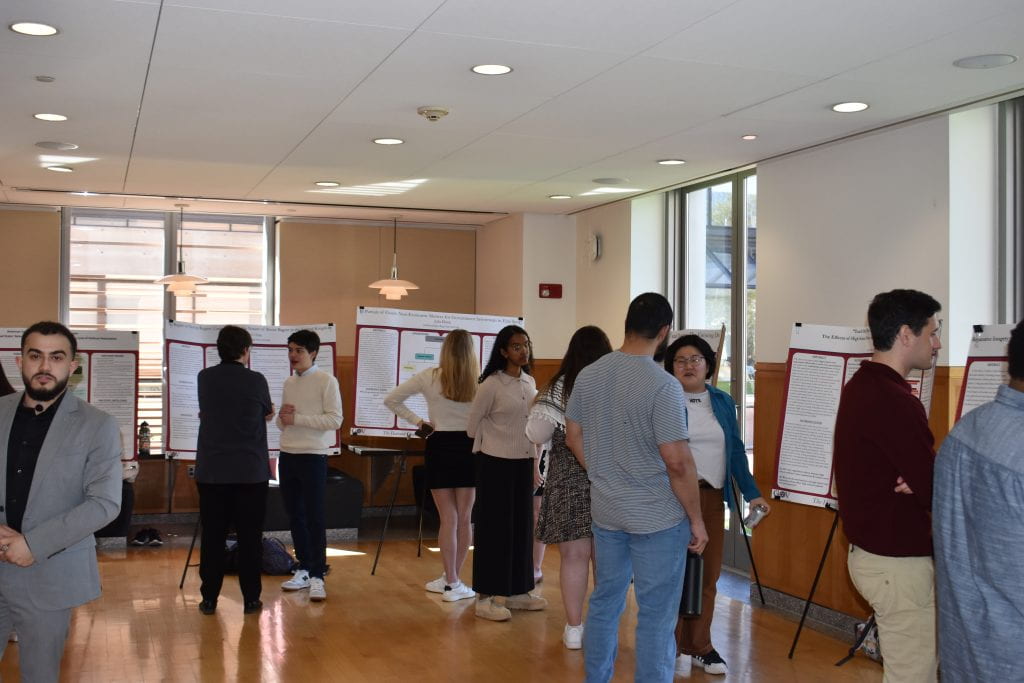
Three of our senior concentrators told us more about their thesis research.
James René Jolin: “A Tale of Two Pandemics: The Differential Effects of COVID-19 Infection and Death on Voter Opinions in the United States”
What is your thesis about?
My focus was on discovering the effect COVID-19 infection and death had on Americans’ attitudes towards their political leaders.
What conclusions did you draw?
Using two nationally representative surveys, I found that, on average, knowing someone who died from COVID-19 reduces Americans’ support for Trump and lower-level Republican candidates but increases support for Biden and Democrats. Conversely, individuals who contract COVID-19, recover, and do not know anyone who died show significantly higher support for Republicans and lower support for Democrats. These effects hold across Democrat- and Republican-identifying survey respondents but are most pronounced among Independents.
These effects are likely explained by how these distinct COVID-19 experiences alter individuals’ perception of the pandemic’s severity. Those who contract COVID-19 but do not know anyone who died show significantly less concern over the coronavirus and strongly oppose pandemic economic restrictions such as business closures, corresponding to increased support for Republicans. The reverse is true for those who experience a COVID-19 death.
These novel findings improve existing theories of crisis politics, which heretofore have neglected to explore how distinct crisis experiences reshape voters’ perceptions of a crisis itself. More broadly, my findings suggest personal crisis experiences can meaningfully alter Americans’ attitudes toward their political leaders, even in an era of acute partisan polarization.
Why did you choose this topic for your thesis?
My interest initially sparked in a Gov50 class in my Sophomore year – the crisis politics literature is replete with theories but has, by and large, neglected the heterogeneity of crisis outcomes. I therefore felt there were some interesting data gaps that I wanted to explore, specifically investigating the impact of diverse crisis experiences on voter attitudes and behavior.
What are your next steps following graduation?
I will be going on to do a Masters at Cambridge University in England.
Alexander E. Chan: “To Regret or Not To Regret: Understanding the Nature of Brexit Regret in the United Kingdom”
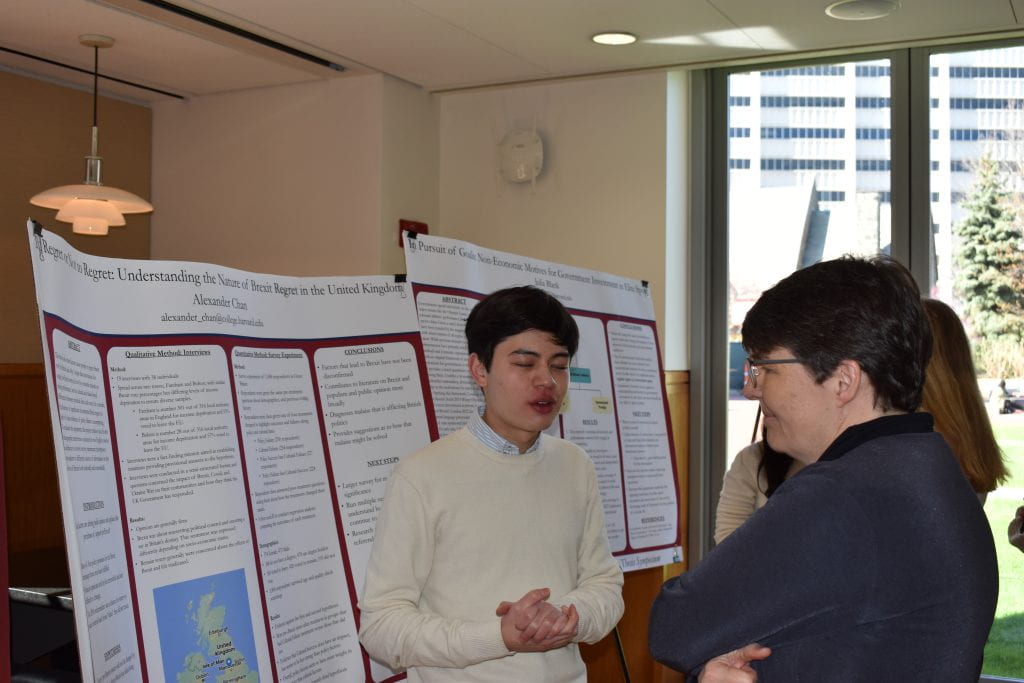
My thesis asks what factors cause people to regret their vote for Brexit and why. I argue that motivations for voting for Brexit were led not by economic reasons or policy preferences, but by cultural and values-based differences between political elites and voters. As a result, the absence of significant documented Brexit regret in light of clear evidence of policy failure is unsurprising.
To evaluate the argument, my project employs data from ethnographic interviews conducted in two English towns in addition to a novel survey experiment that exposes respondents to different sources of information on the effects of Brexit both culturally and economically.
The key takeaways were:
- Evidence against my first and second hypotheses (which were: 1. Voters’ pro-Brexit stances will not be changed by information that shows Brexit has failed along policy dimensions. 2. Voters’ pro-Brexit stances will be changed by information that shows that changes to political culture have not occurred.)
- More pro-Brexit views after treatment in groups that had ‘cultural failure’ treatment versus those that did not
- Evidence that ‘cultural success’ does have an impact, but seems to be less strong than policy factors
- Overall, policy factors seem to have more weight in this survey than cultural factors
What are the next steps?
To move this research on, the next steps would be to run a larger survey for more statistical significance as well as multiple surveys over time to understand how public opinion will continue to evolve. The piece would also benefit from research regarding populism and referendums in other countries.
Brandon L. Kingdollar: “A Sleeping Watchdog? Examining the Impact of Declining Local News on Coverage of Corruption”
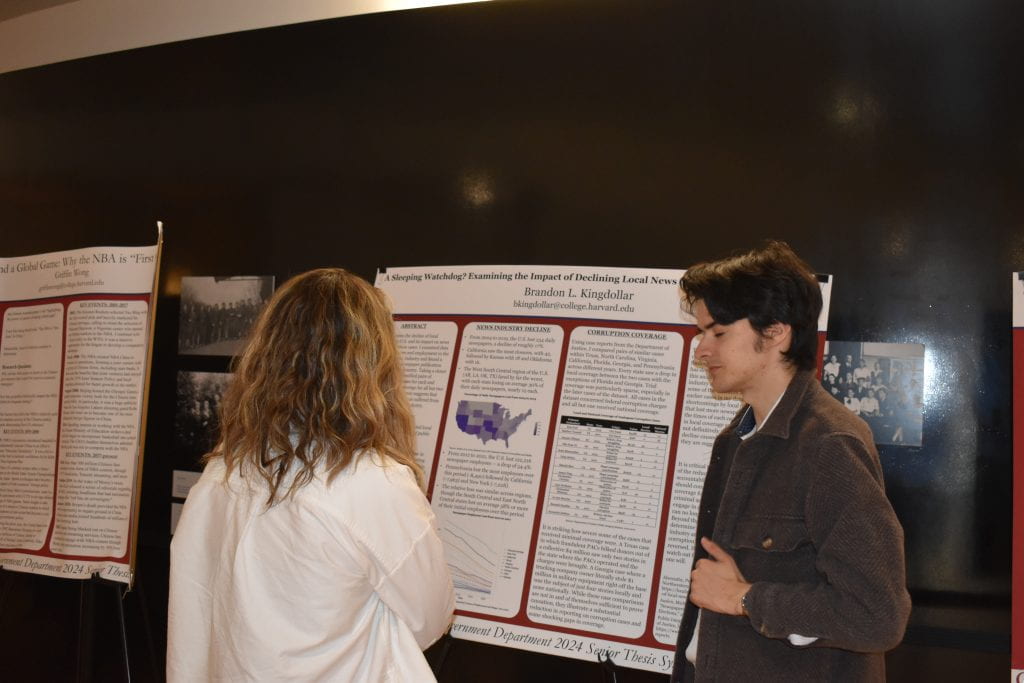
My thesis examines the decline of local journalism in the U.S. and its impact on news coverage of corruption cases. I examined data on newspaper closures and employment in the newspaper publishing industry and found a sharp contraction in newspaper publication and staffing across the country.
Taking a closer look at seven states, I identified pairs of comparable corruption cases for each and found a decline in local coverage for all but two of the case pairs. This evidence suggests that local coverage of corruption has suffered from the decline of the newspaper industry.
The newspaper industry has shrunk considerably in the last two decades, and my findings suggest that coverage of corruption has declined as a result. This analysis must begin with the newspaper industry already amid its contraction —and some of the absences in coverage for even the earlier cases in my dataset show major shortcomings by local outlets.
Generally, states that lost more newspaper employees between the times of each case also saw sharper declines in local coverage and vice versa. My findings do not definitively show that local journalism’s decline caused this reduction in coverage, but they are suggestive of that dynamic.
I will be doing an internship at the Tampa Bay Times, looking specifically at investigative politics – so I look forward to bringing my studies and thesis research to this role.
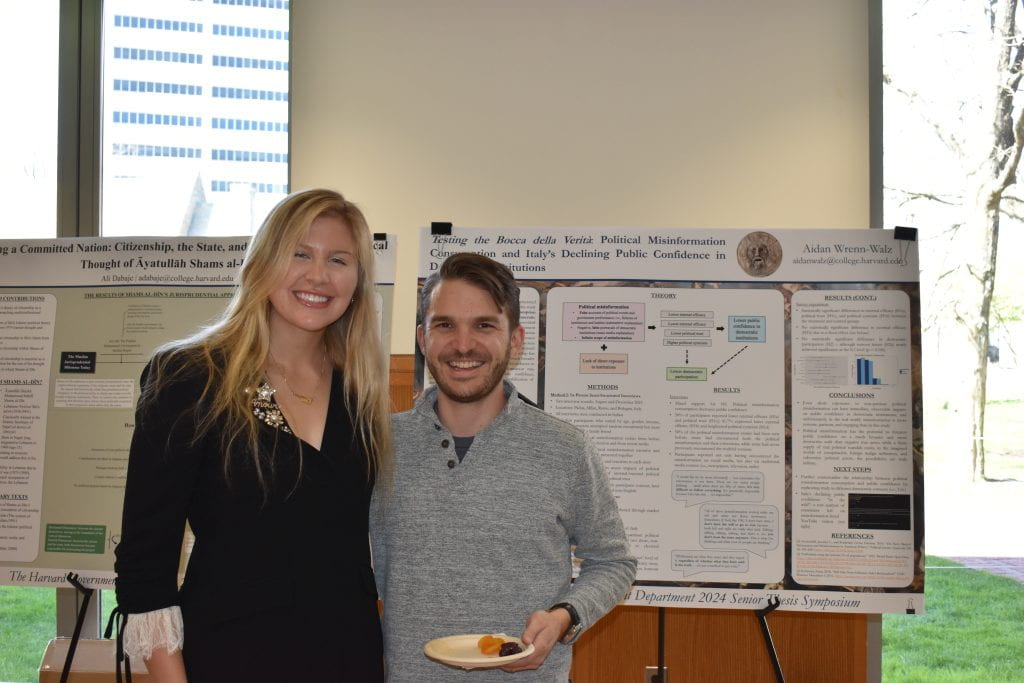
Well done to all our senior thesis writers! Find out more about the undergraduate course at gov.harvard.edu/undergraduate

COMMENTS
How I Use Google tools to Structure Writing. 1. Number the step in each assignment: In one assignment, I ask students to compare theme across two texts. It sounds simple enough, but when I number each step of the scaffolded writing process in Google Classroom, communication with my students becomes so much clearer.
WRITE A LETTER TO GRANDPARENTS Keep notecards and stationery on hand for letter writing. A letter from a grandchild is always a delight. Bad spelling and punctuation is overlooked! WRITE A PICTURE STORY Draw a line about 2/3 down on a sheet of art paper. Let the child draw a picture of anything she wishes at the top.
Writing Process Presentation. This presentation is designed to introduce your students to three major elements that constitute the writing process (invention, composition, revision) and the strategies for inventing, composing, reviewing, and proofreading. The eighteen slides presented here are designed to aid the facilitator in an interactive ...
Strategy Guide. Developing Persuasive Writing Strategies. This strategy guide describes the techniques used in effective persuasive writing and shares activities you can use to help students understand and use persuasion in their writing and critical thinking. Grades.
Best Practices in Teaching Writing 4 Write in the Middle students have to write with exactly the same purpose or for the same audience. When students write about issues, needs, problems, or subjects they find important and ... doing presentations for younger students or for parents and families, creating a class publication, posting writing on ...
In this FLM, students are asked to complete a fill-in-the-blank outline which accompanies all three videos, covering the topics of designing visual presentations as well as presenting them. The completed outline will enhance the students' note-taking skills and will serve as a summary of the FLM that they may refer to in the future. purpose ...
Key skill areas necessary for effective presentations. Oral vs. written communication. Oral Presentation Preparation. Preparing on your own. Working together with a group. Creating slides and/or handouts for presentations. Summarizing and Tips. Pacing. Intonation.
Topic 4 Approaches to teach writing (1).ppt - Free download as Powerpoint Presentation (.ppt), PDF File (.pdf), Text File (.txt) or view presentation slides online. The document discusses several approaches to teaching writing. It describes the controlled-to-free approach which progresses from controlled sentences to free composition. It also covers the process approach where students engage ...
Continuing the Conversation After Presentations. In-Class Writing Especially in WR 111 or WR 112, instructors may ask students to write in class based on a question, point, or quote that arose in a peer's oral presentation. ... Boston University Teaching Writing 100 Bay State Road, 3rd Floor | Boston, MA 02215 617-358-1500 [email protected]
Teaching The Basic Steps Of The Writing Process. Part of our job as teachers is to equip our students to become independent writers. We do this by teaching them the writing process and different strategies that can be used for various purposes. The number of steps in the writing process will differ according to the age of the students.
Teaching writing • Pre-writing. Focus on useful. TEACHING WRITING www.geoffbarton.co.uk Model it Demonstrate. Conclusion. At the end, Bibliography Adrian Doff, Teaching writing - Download as a PDF or view online for free.
'Four Square' Michele Morgan has been writing IEPs and behavior plans to help students be more successful for 17 years. She is a national-board-certified teacher, Utah Teacher Fellow with Hope ...
Two (Mini) Stories about Your Name. This ice-breaker activity offers students an opportunity to get to know each other by telling two (mini) stories about their names in two 1-minute presentations, each taking a different perspective. Students will practice presenting ideas to new audiences in a concise manner and develop rhetorical awareness ...
Published on October 8, 2021 by Tegan George and Julia Merkus. Revised on July 23, 2023. We have adapted several of our most popular articles into lecture slides that you can use to teach your students about a variety of academic topics. Scribbr slides are free to use, customize, and distribute for educational purposes.
As a document intended for use primarily (but not exclusively) by formal educators, the principles here may serve to guide courses, assignments, activities, and work with writers and writing (or composed knowledge) within and beyond the formalized curriculum. Principle 1.1: Writing is social and rhetorical.
This PowerPoint presentation provides the complete guide to writing an effective informative text. It has been designed to teach your students about the text structure and language features of informative texts in a clear and logical sequence. The presentation includes: three examples of informative texts for students to read and analyze.
Writing guide - Years 3 to 10 18. use of effective questioning and prompting to guide students to use and experiment with grammar and punctuation. supporting students to monitor, evaluate and refine their compositional choices. provides opportunities for independent practice.
Authors must think about…. • The purpose of their writing • The audience they are writing for • The content (structure / sequence) ( genre / register) #2 Writing First Draft Putting your ideas and thoughts together Forming sentences and paragraphs. #3 - Editing Revising and Reflecting Rewriting or rearranging sentences.
Presentation Transcript. Teaching Writing Skills Writing is a communicative skill to send, store and retrieve messages with the help of written symbols. Microskills for Writing Some are as follows: • Produce graphemes and orthographic patterns of English • Produce writing at an efficient rate of speed to suit the purpose • Produce an ...
The five stages of writing are planning, drafting, revising, editing and publishing. This PowerPoint is a great resource to use with your child to help guide them through the writing process. It provides easy to follow, step-by-step instructions on how to plan, draft, revise, edit and publish a well written piece.
Is there any chance to share the course Teaching Writing again? Thanks in Advance. Log in or register to post comments; Submitted by Cath McLellan on Thu, 02/29/2024 - 11:05. In reply to Inquiry about the Teaching Writing Course by Atta A. Ahmed. Teaching Writing course. Hi Atta.
writing. In this chapter, I will present a brief historical overview of various approaches to. teaching writing, including the controlled approach, process approach, and genre approach. Essential ...
Teaching of Writing Advanced Certificate. Print-Friendly Page (opens a new window) (SIMS Code: 112299) Offered by the Department of Rhetoric and Writing Studies, the Advanced Certificate in the Teaching of Writing provides opportunities for teachers, scholars, and other professionals to expand their knowledge of rhetoric, expository texts, and ...
Ways to Teach with the Boothe Essays; Working with Lunsford Presentations. Lunsford Winners by Discipline and Subject; Building a Lunsford Presentation; Ways to Teach with the Lunsford Presentations; Facilitating Effective Peer Review Sessions. Further Reading & Resources for Peer Review; Teaching Style. Further Reading & Resources for Style
Project Title Speechwriting and Public Presentation Skills (FY 2024-2025) Project Area Education Beneficiary Countries Cambodia, Lao PDR, Myanmar and Viet Nam (CLMV) Source of Funding Singapore Approved Budget USD 69,842.6 Project Description Activities: • Delivery of training course on English Language. Outputs:
High-quality career and professional skill development took center stage last week as over 600 high school and college students took part in the annual SkillsUSA State Leadership and Skills Conference.Held in Ankeny at the Des Moines Area Community College campus, this two-day competition featured over 50 different leadership and technical competitions for students to test their technical ...
3:45 p.m. - 4:30 p.m. - Five winners from the VPAA Small Grants Program for using AI in teaching will provide five minute presentations in their areas of research. These grants were awarded to 10 UB faculty members who each received $5,000 to develop and discover new ways to incorporate AI in the classroom. The presenters are:
Last week (04/24) we hosted the annual Undergraduate Thesis Symposium, where 39 of our senior concentrators presented their research to peers, faculty, and junior concentrators interested in writing a dissertation. Held at CGIS Fisher Family Commons, the well-attended event saw a wide range of topics and presentations, from contemporary American politics - such as "Teach...